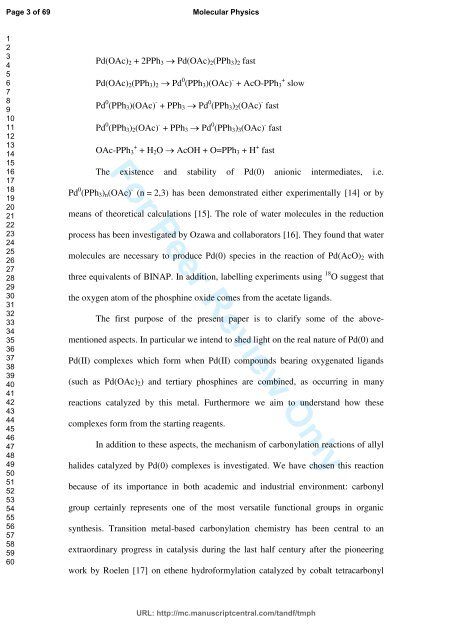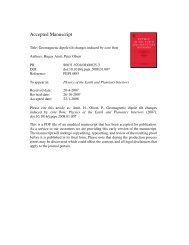For Peer Review Only - TARA
For Peer Review Only - TARA
For Peer Review Only - TARA
You also want an ePaper? Increase the reach of your titles
YUMPU automatically turns print PDFs into web optimized ePapers that Google loves.
Page 3 of 69<br />
Molecular Physics<br />
1<br />
2<br />
3<br />
4<br />
5<br />
6<br />
7<br />
8<br />
9<br />
10<br />
11<br />
12<br />
13<br />
14<br />
15<br />
16<br />
17<br />
18<br />
19<br />
20<br />
21<br />
22<br />
23<br />
24<br />
25<br />
26<br />
27<br />
28<br />
29<br />
30<br />
31<br />
32<br />
33<br />
34<br />
35<br />
36<br />
37<br />
38<br />
39<br />
40<br />
41<br />
42<br />
43<br />
44<br />
45<br />
46<br />
47<br />
48<br />
49<br />
50<br />
51<br />
52<br />
53<br />
54<br />
55<br />
56<br />
57<br />
58<br />
59<br />
60<br />
Pd(OAc) 2 + 2PPh 3 → Pd(OAc) 2 (PPh 3 ) 2 fast<br />
Pd(OAc) 2 (PPh 3 ) 2 → Pd 0 (PPh 3 )(OAc) - + AcO-PPh + 3 slow<br />
Pd 0 (PPh 3 )(OAc) - + PPh 3 → Pd 0 (PPh 3 ) 2 (OAc) - fast<br />
Pd 0 (PPh 3 ) 2 (OAc) - + PPh 3 → Pd 0 (PPh 3 ) 3 (OAc) - fast<br />
OAc-PPh + 3 + H 2 O → AcOH + O=PPh 3 + H + fast<br />
The existence and stability of Pd(0) anionic intermediates, i.e.<br />
Pd 0 (PPh 3 ) n (OAc) - (n = 2,3) has been demonstrated either experimentally [14] or by<br />
means of theoretical calculations [15]. The role of water molecules in the reduction<br />
process has been investigated by Ozawa and collaborators [16]. They found that water<br />
molecules are necessary to produce Pd(0) species in the reaction of Pd(AcO) 2 with<br />
three equivalents of BINAP. In addition, labelling experiments using 18 O suggest that<br />
the oxygen atom of the phosphine oxide comes from the acetate ligands.<br />
The first purpose of the present paper is to clarify some of the abovementioned<br />
aspects. In particular we intend to shed light on the real nature of Pd(0) and<br />
Pd(II) complexes which form when Pd(II) compounds bearing oxygenated ligands<br />
(such as Pd(OAc) 2 ) and tertiary phosphines are combined, as occurring in many<br />
reactions catalyzed by this metal. Furthermore we aim to understand how these<br />
complexes form from the starting reagents.<br />
In addition to these aspects, the mechanism of carbonylation reactions of allyl<br />
<strong>For</strong> <strong>Peer</strong> <strong>Review</strong> <strong>Only</strong><br />
halides catalyzed by Pd(0) complexes is investigated. We have chosen this reaction<br />
because of its importance in both academic and industrial environment: carbonyl<br />
group certainly represents one of the most versatile functional groups in organic<br />
synthesis. Transition metal-based carbonylation chemistry has been central to an<br />
extraordinary progress in catalysis during the last half century after the pioneering<br />
work by Roelen [17] on ethene hydroformylation catalyzed by cobalt tetracarbonyl<br />
URL: http://mc.manuscriptcentral.com/tandf/tmph
















